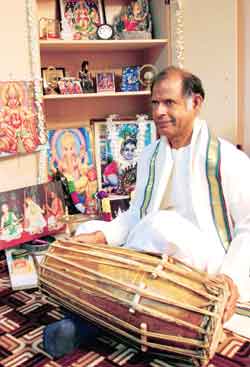Rama Bhat’s rich extracurricular life

Rama Bhat mixes relaxation with his scientific pursuits when he plays Indian music, using such instruments as a mridanga, a classical drum with special acoustic characteristics.
He wrote a paper for the Journal of the Acoustical Society of America in which he described the harmonic nature of the mridanga’s sound because of its composite membrane construction.
There is granite stone and rice powder pasted in the centre, with the frequency of the instrument’s sounds tested as each layer is applied. It is possible to have up to nine harmonics in the sounds played on the mridanga, Bhat said.
This means the instrument’s sounds cover a range of up to nine octaves, with its sounds harmonizing together, each one an octave apart. The special acoustic characteristics of the instrument “make the music relaxing and also appeals to my inquisitive side,” he said.
His study of the acoustic characteristics of traditional instruments began with three scientific papers on sounds produced by conch shells. When the shell is cut open, there is a spiral inside that makes it a wind instrument similar to a trumpet.
Several cultures use conch shells, including in Greece, China, Japan and India, because it can play sounds that are in tune and cover up to 10 octaves. In India, conch shells are used in temples, perhaps because their melodious sounds have frequencies that are soothing and make meditation easier, as opposed to sounds that are harsh because they lack a frequency relationship.
Caption and photo by Robert Winters
There’s more to Rama Bhat than engineering. The longtime professor and academic administrator just published a book that reflects his deep interest in Hindu tradition.
The Divine Anjaneya is about the divinity in the form of an ape, a figure well known to Hindus. Bhat remembers being told stories about Anjaneya by his father when he was a child, but he wrote this 220-page book to communicate with readers in China.
As Bhat relates in his introduction, he went to Nanjing in 2001 with his colleague in the Mechanical and Industrial Engineering Department, Mingyuvan Chen, who subsequently gave him a book on Chinese mythology called Journey to the West. A mythological novel written in the 16th century, it tells of a Chinese Buddhist priest who travels to India during the Tang dynasty (618-907 CE) to acquire Buddhist scriptures.
Bhat was intrigued because of the resemblances of the Indian figure Anjaneya to a Chinese monkey-god called Sun Wukong. He decided to write his book in English, and another colleague, Professor Chun-Yi Su, is having it translated into Mandarin.
To Western readers, Anjaneya’s life resembles that of a modern superhero or one of the gods of Greek or Roman antiquity. There are miraculous transformations, stupendous love stories, fierce battles and acts of vengeance — all the ingredients of enduring myth.
Bhat says that divinity in non-human form is common in Hinduism. “Hindus believe in the incarnation of the supreme in all living forms. The fish, the turtle, the bear, the man-lion form are among the 10 incarnations of Lord Vishnu known as Dashayatara.”
Anjaneya is revered not for his monkey shape but despite it, for his many virtues. Bhat says children who are afraid when the lights are turned out are told to concentrate on Anjaneya.
“The attributes of Lord Rama, Lord Vishnu, or God, are considered to be divine, and some of those individual attributes are personified in Anjaneya. He is courageous, a loyal devotee of Rama, a scholar, an excellent musician and a teacher.”
Bhat personifies some of those qualities himself. He wrote a book of poems in his native language, Kannada. A devoted teacher, he is currently working with 15 graduate students, supervising six of them and co-supervising the others.
Several years ago he was so concerned about the communication deficits of some of his Chinese graduate students that he held English classes for them. His method was to get them to recite Newton’s Laws of Motion and bits of Shakespeare to overcome some of their shyness, and to speak English to each other.
His field of research is vibration and structural acoustics, which dovetails nicely with the involvement of the entire Bhat family in Indian classical music. He plays percussion. His wife is a music teacher and an executive of Bharatiya Sangeetha Sangham, the Indian Music Association. Their two daughters are experts in classical Indian Carnatic music, one on the violin and the other as a vocalist, and both are trained in classical dance, or Bharata Natya.
Recently, Bhat has been taking lessons in guitar. He is doing an undergraduate degree in music at Concordia a few courses at a time, and finds it fascinating. “The scales of Indian and Western music are quite similar,” he said.
This year is Bhat’s thirtieth in North America. He worked for three years at the NASA Langley Research Center in Virginia on aircraft noise reduction, and came to Canada and Concordia in 1979.
Over the years, he has been chair of the Department of Mechanical and Industrial Engineering and president of the Canadian Society for Mechanical Engineering (CSME). He is currently Associate Dean, Graduate Programs and Research, in the Faculty of Engineering and Computer Science.